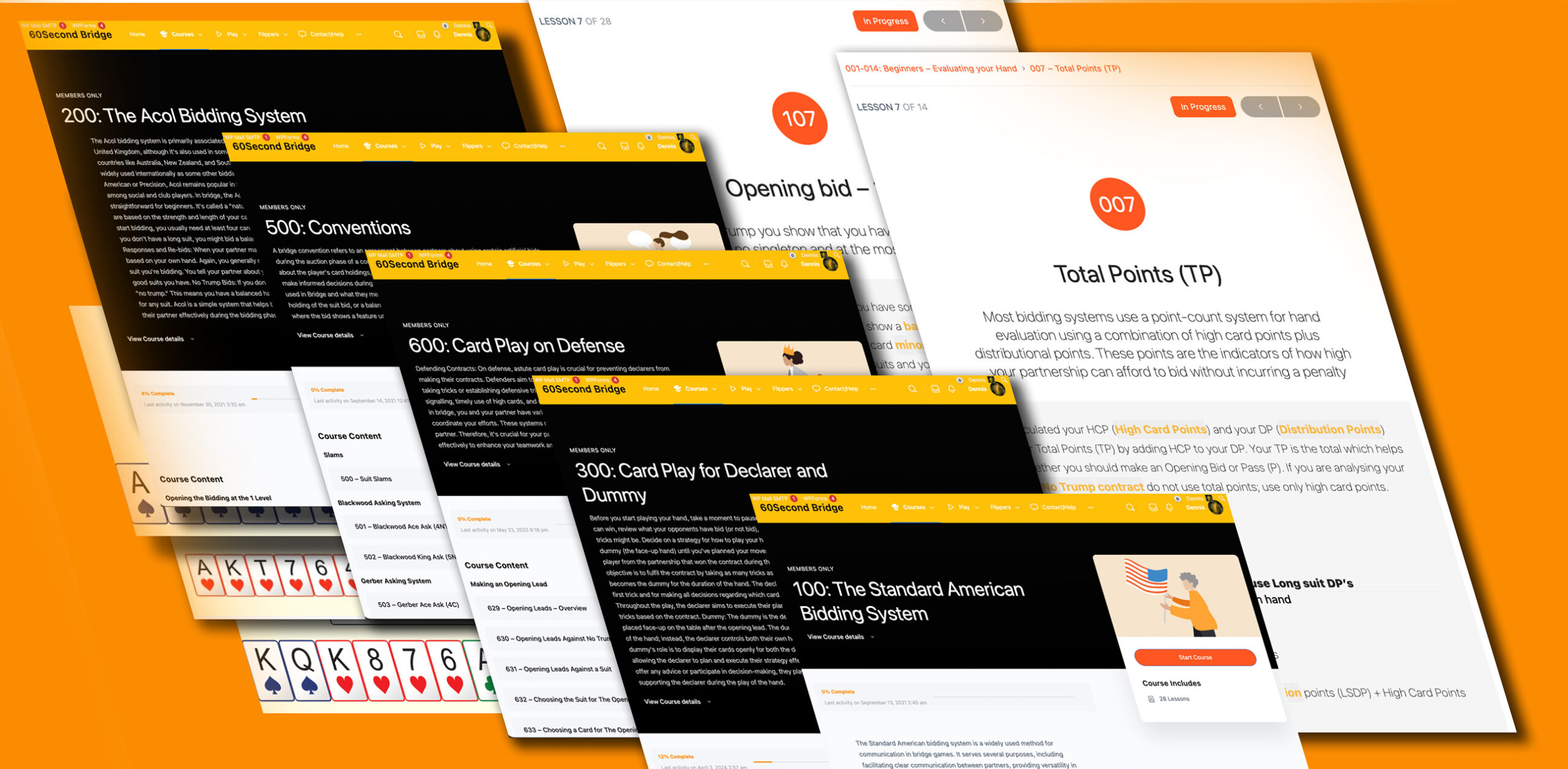HOME > BRIDGE LESSONS > BEGINNERS BRIDGE LESSONS
Bridge Terms
These beginner Bridge lessons are for absolute beginning players and contain essential information you will need as you learn to play Bridge – later bridge lessons will be much harder if you don’t learn the basic Bridge terminology.
After reviewing the basic Bridge terms below, complete the remaining 12 Bridge lessons for beginners, then take the (members only) interactive Bridge quiz at the end.
If you don’t get close to 100%, review the relevant beginner lessons again. Once you are close to 100% in the quiz you can begin learning a bidding system. Especially if you already have some card game experience in games like ‘500’, ‘Whist’ or ‘Euchre’ you will then, by using the (members only) in-built bidding hints in our online Bridge game you will be able to start playing Standard American Bridge or Acol Bridge straight away.
Brief Description of a Bridge Game
Review these bridge terms but don’t worry about memorising them all now, as they will be explained in detail in upcoming lessons. In our members area the lessons include inline definitions that can be revealed by clicking or moving the mouse over the Bridge terminology.
The Cards
Every player holds 13 cards dealt from a deck of 52 cards. Cards are from highest to the lowest: Ace (A), King (K), Queen (Q), Jack (J), and 10 (T), 9, 8, 7, 6, 5, 4, 3, 2.
The Game
The Objectives To win a contract with bids, and then play the hand getting the number of tricks you bid for, based on the cards in your hand. The minimum you can bid is for 7 tricks, so counting of bids starts at 7 eg. a ‘1’ bid means you promise to win 7 tricks.
Positions Player positions are named by compass points. While playing on the 60SecondBridge your default position will always be South (S) and your partner, North (N). Your Partner opposite you, will be named either North(N) – South(S), or East(E) – West(W).

This page is a ‘lite’ version of the interactive lesson in our Premium Area
Subscribe today to our free ‘Bridge Hand of the Week‘ newsletter and, as a bonus, get free instant access to our online beginner Bridge Courses – 31 interactive Bridge lessons (the Premium Members’ version) and 32 guided Bridge hands to play in our Premium Members area.
Our ‘Bridge Hand of the Week’ newsletter is a free guided Bridge game to play each week.
No spam. No login required. Pure Bridge tips and Bridge games to play.
The Bidding
Dealer: The Dealer (D) who is the player with the first turn to bid. If Dealer chooses not to bid and passes (P) bidding proceeds taking turns in a clockwise direction. If four players in the first round of bidding Pass (P), then the hand is not played.
Trump Suit: can be Spades, Hearts, Diamonds or Clubs.
NoTrumps: The contract can be in NoTrumps, with no trump suit and the highest card of the suit led, wins the trick.
Bidding is Finished when three players in a row have passed the bidding.
The Bridge Contract: won by the player who makes the highest bid.
The Defense: is the partnership that does not win the contract known as the defenders (or the defense) they try to play well and take the opponents down.
Playing the Game
The Opening Lead The defense are the first to start the play. The player next to play after declarer is allowed to play any card of their choice, the other players must follow suit if they can. A player who cannot follow suit may discard, or trump if the contract is in a trump suit.
Declarer is the person who gets to play the hand. The first person who bids the winning suit is the declarer.
Dummy is declarer’s partner and after the opening lead, puts all their cards on the table face up taking no more part in that game.
The Defense
Overcaller a defender who has not made the first bid but is not the partner of the opening bidder
Overcallers partnerThe partner of the first defender ‘overcaller’ to make a bid after the opening bid
It is the job of the defender to the left of declarer to make the opening lead, choosing a card and a suit of his choice.
The 60SecondBridge website is divided into two sections, our ‘Public Lessons’ and our ‘Members Only’ section. The table below outlines the differences between the two areas.
MEMBERS AREA LESSONS AND BRIDGE GAMES
‘Members Area’ lessons include inline glossaries for bridge terms, ‘test your knowledge’ instant quizzes and multiple practice hands for each lesson (see video below).
Our members-only lessons are a much faster and more effective method of learning Bridge.
FREE ACCESS TO THE FIRST 2 BEGINNERS COURSES (no registration required)- Quick Start – Learn By Playing Bridge (5 lessons)
- Bridge Hand Evaluation (14 lessons)
MEMBERS-ONLY SUBSCRIPTION - Standard American bidding System (28 lessons)
- Acol Bridge Lessons (26 lessons)
- On Defense – Bidding and Card Play (36 lessons)
- Bridge Conventions in Bridge (14 lessons)
- Declarer Card Play (16 lessons)
Our members area also includes unlimited random practice hands to play online, daily Bridge competitions and a daily ‘Hand of the Day’ game with a guided commentary.
PUBLIC LESSONS (text only)
Our public lessons are text and some images, they are not interactive and generally do not include practice hands. See the members area for a more effective method of learning bridge.


